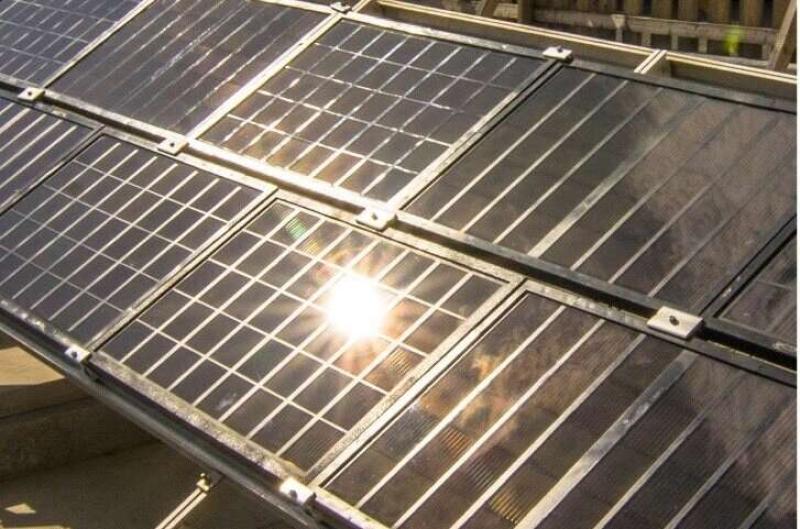A stand-alone solar farm in Crete that integrates graphene perovskite solar panels
Category: Health, Science & Technology
Via: hallux • 3 years ago • 3 commentsBy: Ingrid Fadelli , Tech Xplore


Perovskites, mineral materials composed of calcium titanate, have been found to be valuable for the fabrication of high-performance solar cells. While teams of scientists and engineers worldwide have been developing and testing perovskite solar cells in laboratory settings, large-scale outdoor evaluations of these cells are still lacking.
Researchers at University of Rome Tor Vergata, the Hellenic Mediterranean University in Crete, BeDimensional S.p.A., Great Cell, the Italian Institute of Technology (IIT) and University of Siena have recently manufactured large-area perovskite solar panels engineered using two-dimensional (2D) materials. They then successfully integrated 9 of these solar panels into a stand-alone solar farm , located on the Greek island of Crete. This team's findings, presented in a paper published in Nature Energy , could facilitate and inform the future large-scale implementation of perovskite solar cells .
"Our recent paper highlights our joint research efforts for the last 5 years in the upscaling of perovskite PVs, starting from lab cells to modules, panels and finally to a solar farm infrastructure," Francesco Bonaccorso, one of the researchers who carried out the study, told to Tech Xplore. "This project was specifically developed in the context of the European Graphene Flagship initiative, which established a close collaboration between University Tor Vergata, BeDimensional S.p.A., GreatCell and Hellenic Mediterranean University, having both complementary and widely different skillsets."
The recent collaborative work by these different universities and organizations was selected as the spearhead project of the Graphene Flagship initiative. This is an initiative the focuses on the industrialization and deployment of solar energy harvesting technologies.
The team first published results of their collaborative efforts in, Advanced Functional Materials in 2016. In this paper, the team opened a new research field in the context of perovskite photovoltaics, demonstrating that by properly engineering the interfaces with 2D materials it was possible to significantly increase the stability of perovskite solar cells.
"Following our first publication on small area cells (both 0.1 and 1 cm 2 ), we developed the feasibility of this technology on large area devices, bringing it at the module level (hundreds cm 2 )," Aldo Di Carlo, another researcher involved in the study, said. "The primary objective of our recent work was to demonstrate the ultimate scaling up of this technology at the solar farm level (meter 2 ). In doing so, we were able to validate the Perovskite technology at such scale for the first time."
Before they started working on their stand-alone solar farm, the researchers manufactured 9 solar panels based on the 2D material GRAphene-PErovskite (GRAPE). Each of these panels had an area of 0.5 sqm, and was comprised of 40 perovskite modules per panel, which were connected to one another.
Subsequently, the team used these 9 solar panels to create the first autonomous solar farm in the world. Their solar farm, located at the Hellenic Mediterranean University campus in Crete, has a total panel area of 4.5m 2 .
"We also built the required supporting infrastructure, data acquisition systems and a weather station ," Emmanuel Kymakis, another researcher involved in the study, said. "This allowed us to continuously monitor the solar farm, correlating the environmental conditions with the outdoor performance of the system. Being the first demonstration of this technology at such scale, it, per se, represents a unique design. Moreover, the solar farm performance and weather data are uploaded in an online repository, allowing the research community exploration ( solarfarmhmu.gr )."
The coordinated work of the groups led by Bonaccorso, Kymakis and Di Carlo proves that perovskite solar panels can be successfully and efficiently implemented on a large-scale. The team also collected measurements and data at their solar farm throughout the course of their study. This data could prove highly valuable for understanding the strengths and limitations of real-world perovskite solar cell implementations.
"Our results represent an important step toward the commercialization of this technology," Bonaccorso said. "Thanks to the exploitation of 2D materials, our technology demonstrated a state-of-the-art stability. The data we collected at the solar farm will allow us to evaluate the energy production and stability of the perovskite technology in real conditions."
In the future, the data gathered by this team of researchers could guide perovskite solar cell manufacturing processes and help to meet targets for the commercialization of this highly promising solar technology. The life cycle assessment analyses conducted by the team also confirmed that solar farms could play a very important role in tackling climate change. Specifically, the team found that their solar farm's environmental profile was comparable to that outlined in both realistic and optimistic energy estimations for 2050, which consider a mixture of sustainable and traditional sources of electricity.
"The results we obtained indicate that additional efforts are required to improve encapsulant materials and lamination protocol to further extend the lifetime of the panels composing the solar farm," Bonaccorso added. "By conducting a life cycle assessment based on data acquired during the entire fabrication process, from materials to panels and characterization, we should now also be able to identify the significant impact of the manufacturing process. Our future research activities will be aimed at tackling these open questions."
Tags
Who is online
414 visitors

Who invests in this research? 'Evil' governments and of course the hydrocarbon industry who will by hook or crook own solar ... they may be greedy bastards but they are not fools.
Interesting article, and you're correct they are greedy bastards but not fools.
My solar system is about breakeven now, generating modest credits which are eaten up by equally
modest transmission charges from my original electric provider.
We get charged for using the existing infrastructure to send and receive power.
The next project is to replace the remaining original extruded aluminum windows
with decent energy efficient windows.